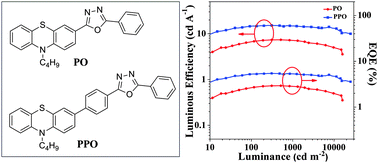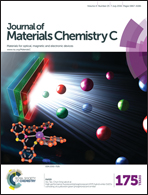Improving the electroluminescence performance of donor–acceptor molecules by fine-tuning the torsion angle and distance between donor and acceptor moieties†
Abstract
The torsion angle and distance between the donor (D) and the acceptor (A) are two important factors in determining the photoluminescence and electroluminescence properties of twisted D–A type organic molecules. Here, two new D–A compounds, 2-(10-butyl-10H-phenothiazin-3-yl)-5-phenyl-1,3,4-oxadiazole (PO) and 2-(4-(10-butyl-10H-phenothiazin-3-yl)phenyl)-5-phenyl-1,3,4-oxadiazole (PPO), were designed and synthesized to tune the torsion angle and distance between D and A moieties, and their photophysical and electroluminescence properties were investigated. The D–A type molecule PO has a planar conformation, whereas the D–π–A type molecule PPO has a twisted conformation because of the insertion of the phenyl bridge between the donor and the acceptor. Therefore, the charge transfer (CT) of PPO is much stronger than that of PO, and the singlet exciton yield of PPO may be higher than that of PO. On the other hand, the introduction of a phenyl unit can also improve the photoluminescence quantum efficiency (doped film ΦPL ≈ 70%). As a result, the PPO-doped device showed better device performance than PO. The device based on PPO as an emitter exhibited stable and high luminous efficiency (15.2 cd A−1, corresponding to an external quantum efficiency of 5.4%), which is increased by about 1.05 fold as compared to the device based on PO as an emitter (luminous efficiency 7.4 cd A−1 and external quantum efficiency 2.9%).


 Please wait while we load your content...
Please wait while we load your content...